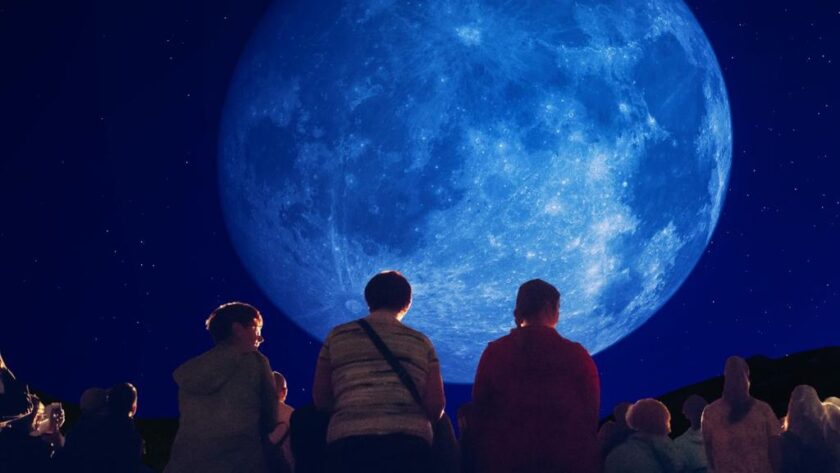In the grand tapestry of celestial events that captivate our beautiful planet, few occurrences are as mesmerizing as the elusive Blue Supermoon. A celestial phenomenon that has intrigued and enchanted stargazers for generations, this rare event is poised to make an awe-inspiring return to our night skies this week.
With its captivating blend of rarity, natural beauty, and celestial wonder, the Blue Supermoon stands as a reminder of the vast cosmic dance that surrounds us at all times. Join us as we embark on a journey to unveil the mysteries and marvels of this infrequent spectacle, delving into its origins, its stunning visual impact, and the unique opportunity it presents to connect with the cosmos this week.
Get ready to witness a celestial masterpiece that unfolds only once every two decades, as the Blue Supermoon takes center stage in the astronomical theater above, reminding us of the breathtaking beauty that resides just beyond the horizon.
What Is The Blue Supermoon?
The term “Blue Supermoon” refers to a rare and captivating celestial event that combines two separate phenomena: a Blue Moon and a Supermoon. Let’s break down each component to understand what makes this occurrence so unique.
Blue Moon
Contrary to its name, a Blue Moon doesn’t usually appear blue in color. Instead, the term “Blue Moon” refers to the occurrence of an extra full moon within a calendar period. Typically, there are three full moons in a three-month season. However, every once in a while, there’s a fourth full moon in a season. This additional full moon is known as a Blue Moon. The phrase “once in a blue moon” derives from the infrequent nature of this event.
Supermoon
A Supermoon is a term used to describe a full moon that coincides with the moon’s closest approach to Earth in its elliptical orbit. This proximity to our planet makes the moon appear larger and brighter in the sky than a regular full moon. The scientific name for this phenomenon is “perigee-syzygy.”
Now, when a Blue Moon and a Supermoon coincide, we get what’s known as a Blue Supermoon. This event is exceedingly rare, as it requires the alignment of both the lunar cycle and the moon’s orbital cycle. The combination of the Blue Moon and Supermoon creates a dazzling spectacle where the moon appears larger and brighter than usual, while also occurring at a time that doesn’t frequently happen.
The term “blue” in Blue Supermoon doesn’t refer to the moon’s color, but rather to the rarity of the event itself. The moon won’t actually appear blue, unless there’s an unusual atmospheric condition that causes scattering of light, such as from a volcanic eruption or a major wildfire.
The Blue Supermoon is a visual treat for sky enthusiasts, offering a chance to witness a celestial marvel that blends the infrequent presence of an extra full moon with the moon’s closest approach to Earth. It’s an event that invites us to gaze upward in wonder and appreciation of the dynamic dance between Earth, our moon, and the cosmos beyond.
Where Will The Blue Supermoon Be Visible?
The visibility of the Blue Supermoon depends on your geographical location and the specific date of the event. Generally, celestial events like this are visible from a large portion of the Earth, but there might be variations in terms of the moon’s appearance and visibility based on your region.
Here’s some general information:
- The Blue Supermoon will be visible from most parts of the world where the night sky is visible and weather conditions are clear. This includes regions in North America, South America, Europe, Africa, Asia, and Oceania.
- However, the exact visibility can vary based on factors such as your latitude, local weather conditions, and light pollution. In areas with less light pollution and clear skies, the Blue Supermoon’s brilliance will be more pronounced and captivating. City lights and atmospheric conditions can sometimes dim the moon’s radiance, but even in such cases, the event is still likely to be visible.
- To determine the exact timing and visibility of the Blue Supermoon in your specific location, it’s recommended to consult local astronomical resources, stargazing apps, or websites that provide information about celestial events and moonrise/moonset times for your region.
Remember that the Blue Supermoon event occurs only once every couple of decades, so taking the opportunity to observe this rare celestial phenomenon can be a memorable and awe-inspiring experience. The anticipation is palpable as news outlets worldwide buzz with excitement, heralding the arrival of what astronomers project to be the “biggest and brightest moon” of the year.
When Is The Next Blue Supermoon?
Mark your calendars for the night of August 30th, 2023 as that is when this celestial ballet is set to take center stage. On this magical night, fortunate observers across the globe will have the chance to witness the captivating radiance of the Blue Supermoon, a sight that has enchanted generations and fuels the imagination of stargazers young and old.
According to astronomical forecasts, the Blue Supermoon will commence its ascent at approximately 7:10 p.m. Eastern Time on August 30th. As it rises above the horizon, its luminous aura will paint the night canvas with an ethereal hue, and this captivating display will continue to unfold throughout the night, casting an enchanting glow upon the world.
But as with all celestial events, the Blue Supermoon will not linger indefinitely. As dawn begins to break on August 31st, the moon will start descending below the horizon at around 6:46 a.m. ET. As we stand on the cusp of this remarkable phenomenon, let us ready our hearts and telescopes to greet the Blue Supermoon with open arms.
Whether you’re an experienced astronomer, a casual observer, or someone venturing into the realm of stargazing for the first time, this event promises a shared experience that unites humanity under the vast expanse of the cosmos. So, let us gather under the starlit canopy and embrace the beauty and rarity of this Blue Supermoon, a cosmic masterpiece that reminds us of the boundless wonders that grace our universe.






